Epson 3250 User Manual
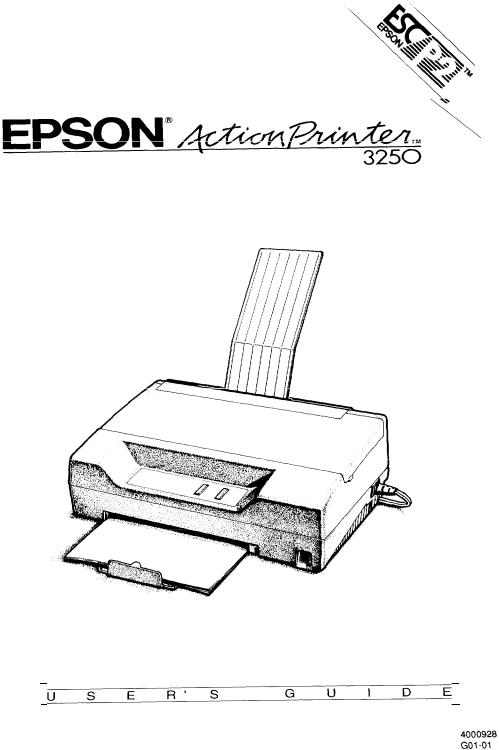
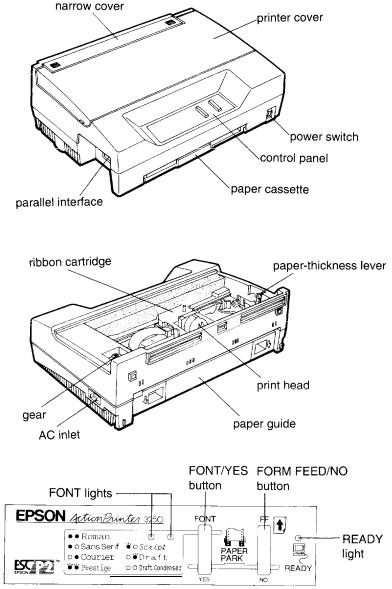
Printer Parts
Control panel

EPSON® Action Printer™
3250
All rights reserved. No part of this publication may be reproduced, stored in a retrieval system, or transmitted in any form or by any means, mechanical, photocopying, recording, or otherwise, without the prior written permission of Seiko Epson Corporation. No patent liability is assumed with respect to the use of the information contained herein. Neither is any liability assumed for damages resulting from the use of the information contained herein.
Neither Seiko Epson Corporation nor its affiliates shall be liable to the purchaser of this product or third parties for damages, losses, costs, or expenses incurred by purchaser or third parties as a result of: accident, misuse, or abuse of this product or unauthorized modifications, repairs, or alterations to this product.
Seiko Epson Corporation shall not be liable against any damages or problems arising from the use of any options or any consumable products other than those designated as Original Epson Products or Epson Approved Products by Seiko Epson Corporation.
Epson and Epson ESC/P are registered trademarks and Epson ESC/P 2 is a trademark of Seiko Epson Corporation.
Copyright © 1991 by Seiko Epson Corporation
Nagano, Japan
User’s Guide
FCC Compliance Statement
For United States Users
This equipment has been tested and found to comply with the limits for a Class B digital device, pursuant to Part 15 of the FCC Rules. These limits are designed to provide reasonable protection against harmful interference in a residential installation. This equipment generates, uses and can radiate radio frequency energy and, if not installed and used in accordance with the instructions, may cause harmful interference to radio or television reception. However, there is no guarantee that interference will not occur in a particular installation. If this equipment does cause interference to radio and television reception, which can be determined by turning the equipment off and on, the user is encouraged to try to correct the interference by one or more of the following measures.
. |
Reorient or relocate the receiving antenna. |
|
. |
Increase the separation between the equipment and receiver. |
|
. |
Connect the equipment into an outlet on a circuit different from that to which |
|
|
the receiver |
is connected. |
. |
Consult the |
dealer or an experienced radio/TV technician for help. |
WARNING
The connection of a non-shielded equipment interface cable to this equipment will invalidate the FCC Certification of this device and may cause interference levels which exceed the limits established by the FCC for this equipment. It is the responsibility of the user to obtain and use a shielded equipment interface cable with this device. If this equipment has more than one interface connector, do
not leave cables connected to unused interfaces.
Changes or modifications not expressly approved by the manufacturer could void the user’s authority to operate the equipment.
For Canadian Users
This digital apparatus does not exceed the Class B limits for radio noise emissions from digital apparatus as set out in the radio interference regulations of the Canadian Department of Communications.
Le présent appareil numérique n’émet pas de bruits radioélectriques dépassant les limites applicables aux appareils numériques de Classe B prescrites dans le réglement sur le brouillage radioélectrique édicté par le Ministére des Communications du Canada.
ii
Important Safety Instructions
. |
Read all of these instructions before you set up your printer. |
. |
Follow all warnings and instructions marked on the printer. |
. |
Unplug the printer from the wall outlet before you clean it, and use a damp |
|
cloth for cleaning, not liquid or aerosol cleaners. |
. |
Do not use your printer near water or spill any liquid on it. |
. |
Do not place the printer on an unstable cart, stand, table or other surface that |
|
may allow the printer to fall. |
. |
Do not block any slots or openings in the cabinet. These are provided for the |
|
ventilation necessary to ensure reliable operation and protection from |
|
overheating. Placing the printer on a bed, sofa, rug, or other similar surface |
|
may block the openings. Also, do not place the printer in a built-in installation |
|
unless proper ventilation is provided. |
. |
Never place the printer near or over a radiator or heat register. |
. |
Use the type of power source indicated on the label. If you are not sure of the |
|
type of power available, consult your dealer or local power company. |
. |
This printer may be equipped with a plug having a third (grounding) pin, |
|
which fits only into a grounding-type outlet. This is a safety feature. If you are |
|
unable to insert the plug into the outlet, have an electrician replace your |
|
obsolete outlet. Do not defeat the purpose of the grounding-type plug. |
. |
Do not put your printer where the cord will be walked on. |
. |
If you use an extension cord, make sure that the total of the ampere ratings on |
|
the products plugged into the extension cord does not exceed the extension |
|
cord’s ampere rating. Also, make sure that the total of all products plugged |
|
into the wall outlet does not exceed 15 amperes. |
. |
Never push objects of any kind into your printer because they may touch |
|
dangerous voltage points or short out parts that could result in a risk of fire or |
|
electric shock. |
. |
Except as specifically explained in the user’s manual, do not attempt to repair |
|
the printer yourself. This could expose you to dangerous voltage points or |
|
other risks. Refer all servicing in those compartments to service personnel. |
i i i

. Unplug the printer from the wall outlet and have it repaired by a qualified service person under the following conditions:
When the power cord or plug is damaged or frayed
If liquid has been spilled into it
If it has been exposed to rain or water
If it does not operate normally when the operating instructions are followed. Adjust only those controls that are covered by the operating instructions since improper adjustment of other controls may result in damage and will often require extensive work by a qualified technician to restore the printer to normal operation.
If it has been dropped or the cabinet has been damaged
If it exhibits a distinct change in performance, indicating a need for service
Where United States Users Can Get Help
Epson America provides local customer support and service through a nationwide network of authorized Epson dealers and Service Centers.
Epson also provides the following support services through the Epson Consumer Resource Center at (800) 922-8911:
Assistance in locating your nearest Authorized Epson Reseller or Service Center
Technical assistance with the installation, configuration, and operation of Epson products
Information on ESC/P 2 drivers for your software
Sales of the ESC/P Reference manual, which contains comprehensive information on ESC/P 2
Epson technical information library fax service
Product literature with technical specifications on our current and new products
Sales of ribbons, supplies, parts, documentation, and accessories for your Epson product
Customer Relations
iv
For United Kingdom Users
Epson product guarantee
Under the law, goods sold must comply with their description and must be of merchantable quality and fit for their purpose or correspond with any sample.
This guarantee does not affect the seller’s legal obligation or the rights of the consumer in the “consumer transactions” under any Statute, including Sections 12 to 15 of the Sales of Goods Act, 1979.
All Epson Products, other than OEM products, are fully guaranteed against faulty operation or performance for a period of ONE YEAR from date of purchase by the user of the product.
All claims under this guarantee MUST be supported by evidence of purchase, normally the bill of sale invoice, and it is the responsibility of the claimant to furnish such proof. Epson (UK) Limited does not issue or operate any form of guarantee registration card.
Claims are made by the user returning the product to the supplier from whom it was purchased or, if this is impractical, to any Epson supplier who also handles the same product. In the event of any difficulty, users are requested to contact the Service Co-ordinator Manager at Epson (UK) Limited.
Epson (UK) Limited, or Epson Appointed Distributors, will at their discretion repair or replace part or all of the product to provide, in their judgement, a satisfactory performance of the product consistent with its age and apparent usage.
This guarantee covers the cost of both the parts and labour required to correct any malfunction of the equipment, but specifically excludes: wear and tear, consumables, physical damage due to incorrect use or misuse and damage or faulty operation due to unauthorized and inexpert repair.
The guarantee is restricted to the performance of the product alone, and Epson (UK) Limited does not accept responsibility for any consequential loss or damage, nor claimed or implied performance, when the product is used in any combination with other equipment or program software.
Product guarantee may be invalidated as a result of excessive or inappropriate use, use in adverse environment or in conditions outside the specifications or if the product has been subjected to unapproved modifications.
The guarantee does not cover visits to the user’s premises or the repair or commissioning of the product on site.
Use of options
Epson (UK) Limited shall not be liable against any damages or problems arising from the use of any options or consumable products other than those designated as Original Epson Products or Epson Approved Products by Epson (UK) Limited.
Safety information
Warning: This appliance must be earthed. Refer to rating plate for voltage and check that the appliance voltage corresponds to the supply voltage.
Important: The wires in the mains lead fitted to this appliance are coloured in accordance with the following code:
Green and yellow -- Earth
Blue -- Neutral
Brown -- Live
As the colours of the wires in the mains lead of this appliance may not correspond with the coloured markings identifying the terminals in your plug, proceed as follows:
The green and yellow wire must be connected to the terminal in the plug which is marked with the letter E or with the earth symbol  or coloured green or green and yellow.
or coloured green or green and yellow.
The blue wire must be connected to the terminal in the plug marked with the letter N or coloured black.
The brown wire must be connected to the terminal in the plug marked with the letter L or coloured red.
If damage occurs to the plug, replace the cord set or consult a qualified electrician.
Replace fuses only with a fuse of the correct size and rating.
vi
Tips for Printing on Single Sheets
There are a few things you should know about printing on single sheets as opposed to continuous paper. When you print on single sheets, you may notice that your printer prints the first page of your file correctly but then prints too low on the next page, or that it prints the last few lines from one page onto the next.
These differences in print position are easy to adjust; you can simply change some of the settings in your application program as described below to get the right results.
1.When you install an application program, it normally asks you what printer you are using. Make sure you choose the correct printer. See Chapter 1 for the right printer to choose.
2.Many programs include an option to set the maximum lines per page. If your program has a lines-per-page setting and you are using 8 1/2 x 11-inch paper, set the lines per page to 61; for A4, try 65.
Note: To find the right lines-per-page setting for paper that is not 8 1/2 x 11, create a test document using your application program. Set your top and bottom margins to 0 and then create a file of numbered lines from 1 to 66. When you print your file, notice the last number printed on the first page. This is your maximum lines-per- page setting.
3.If your program doesn’t have a lines-per-page setting, try decreasing the top margin or increasing the bottom margin, or both, until you get the results you want.
4.You can also try adjusting the form length setting. For a 8 l/2 x 11-inch page, try setting the form length at 10 inches (10.5 inches for A4).
5.Some programs also let you indicate whether you are using single sheets or continuous paper. Make sure you choose single sheets.
vii

Contents |
|
Introduction |
1 |
Features ........................................................................................... |
1 |
Finding Your Way Around .......................................................... |
2 |
Warnings, Cautions, and Notes .................................................. |
2 |
Chapter 1 Setting Up the Printer |
1-1 |
Unpacking the Printer ............................................................... |
1-2 |
Choosing a Place for the Printer ............................................. |
1-4 |
Installing the Ribbon Cartridge .............................................. |
1-5 |
Attaching the Output Guide .................................................... |
1-7 |
Plugging in the Printer .............................................................. |
1-8 |
Running the Self Test ................................................................. |
1-8 |
Connecting the Printer to Your Computer ............................. |
1-11 |
Setting Up Your Application Software ................................... |
1 -13 |
Chapter 2 Paper Handling |
2-1 |
Printing on Single Sheets . . . . . . . . . . . . . . . . . . . . . . . . . . . . . . . . . . . . . 2-2 Using Continuous Paper with the Optional Push Tractor . . . 2-5 Switching Between Continuous Paper and Single Sheets . . . . 2-13 Printing on Special Paper . . . . . . . . . . . . . . . . . . . . . . . . . . . . . . . . . . . . . . . . . 2-15
Chapter 3 Using the Printer |
3-1 |
Operating the Control Panel.. .................................................. 3-2 |
|
Selecting Character Fonts.. ....................................................... |
3-4 |
Using the Default-Setting Mode ............................................. |
3-6 |
Maintenance and Transportation ........................................... |
3-14 |
Troubleshooting ........................................................................ |
3-16 |
v i i i Contents

Appendix |
A-1 |
|
Technical Specifications ........................................................... |
A-1 |
|
Command Summary ................................................................ |
A-12 |
|
Character Tables ........................................................................ |
A-21 |
|
Glossary |
GL-1 |
|
Index |
IN-l |
|
Contents ix

Introduction
Your new Epson® printer is an advanced 24-pin dot matrix printer that combines high performance with a wide range of features.
Features
These features give your Epson printer outstanding value:
Fast printing speed. You can print up to 200 characters per second in 12 cpi draft mode.
Easy paper handling. The built-in paper cassette holds up to 50 single sheets of paper. You can also insert pages manually without removing your paper cassette.
Epson ESC/P 2. Along with font sizes scalable from 8 to 32 points, this powerful printer control language has enhanced graphics for sharp, 360 x 360 dots-per-inch output.
Compatibility. The printer supports the Epson ESC/P® commands widely used in application programs written for other Epson LQ and SQ printers.
Two printer positions. You can set the printer upright or flat, whichever you prefer.
A range of popular fonts. You can choose from two draft fonts and five letter-quality fonts for professional results.
Unique control-panel design. The sleek, two-button panel makes it easy to customize the printer’s default settings.
In addition, you can install an optional push tractor (C80026*) to print on continuous paper, multi-part forms, and labels. Also you can switch between single-sheet and continuous printing without removing either paper supply.
*This number varies by country. See your Epson dealer for the correct number for your country.
Introduction 1
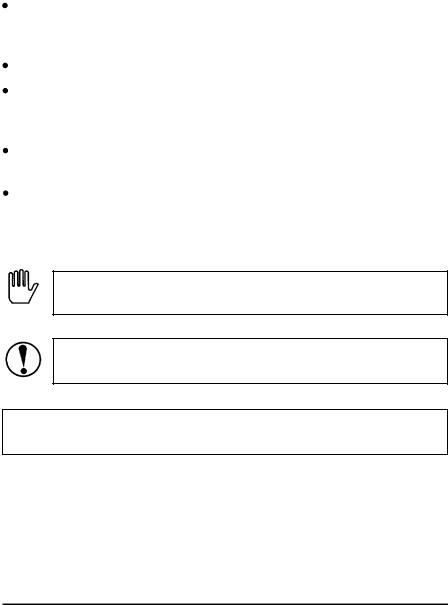
Introduction
Finding Your Way Around
Here’s what you’ll find in this book:
Chapter 1 contains step-by-step instructions for unpacking, setting up, testing, and connecting your printer. Be sure to read and follow these instructions.
Chapter 2 is a detailed discussion of paper handling.
Chapter 3 describes how to use the control panel to customize your printer settings. It also contains maintenance and troubleshooting information.
The Appendix includes the printer specifications, commands, and character tables.
A glossary of printer terms and an index are at the end.
Warnings, Cautions, and Notes
WARNINGS must be followed carefully to avoid bodily injury.
CAUTIONS must be observed to avoid damage to your equipment.
Notes contain important information and useful tips on the operation of your printer.
2 Introduction

Chapter 1
Setting Up the Printer
Unpacking the Printer . . . . . . . . . . . . . . . . . . . . . . . . . . . . . . . . . . 1-2
Removing the protective materials . . . . . . . . . . . . . . . . . . . . . . 1-3
Choosing a Place for the Printer . . . . . . . . . . . . . . . . . . . . . . . . . . . . . . 1-4
Installing the Ribbon Cartridge . . . . . . . . . . . . . . . . . . . . . . . . . . . . . . . . 1-5
Attaching the Output Guide . . . . . . . . . . . . . . . . . . . . . . . . . . . . . . . . . . 1-7
Plugging in the Printer . . . . . . . . . . . . . . . . . . . . . . . . . . . . . . . . . . . . . . . . . . . . . . . |
1-8 |
Running the Self Test ................................................................ |
1-8 |
Loading paper into the paper cassette.. ............................. 1-9 |
|
Running the test .................................................................... |
1-10 |
Connecting the Printer to Your Computer . . . . . . . . . . . . . . . . . 1-11
Setting Up Your Application Software ................................... |
1-13 |
Printing a test file .................................................................. |
1-14 |
Setting Up the Printer |
l-l |
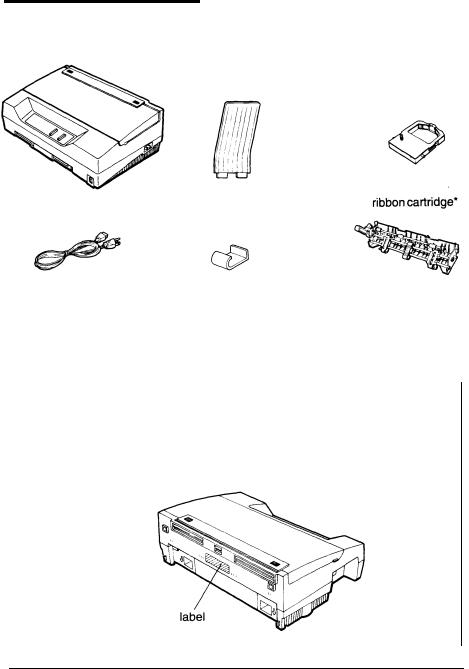
Unpacking the Printer
Your printer box should include these items.
printer |
output guide |
power cord** |
cable clip |
push tractor*** |
*The ribbon cartridge is attached near the parallel interface connector with a piece of tape.
**In some locations, the power cord is attached to the printer.
***In some countries, the push tractor is an option (part number C80026*).
CAUTION: There are several versions of this printer designed for different voltages, and it is not possible to change the voltage. If the label on the back of the printer does not show the correct voltage for your country, contact your dealer.
1-2 Setting Up the Printer
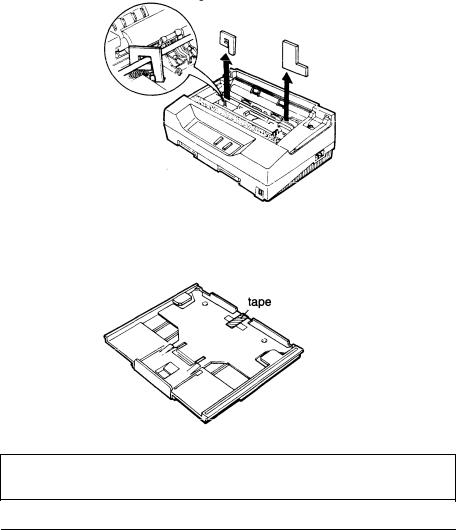
Unpacking the Printer
Removing the protective materials
During shipping, a print head protector and a piece of tape protect the printer and paper cassette. Before you use the printer, you must
“remove these protective items.
1.Use the tabs on both sides of the printer cover to lift it off the printer. First remove the protective cover. Then remove the two protectors from inside the printer.
2.Pull the paper cassette out of the printer. Remove the tape that holds down the metal plate in the cassette during shipping.
Note: Store these protective items with the other packing materials.
Setting Up the Printer |
1-3 |
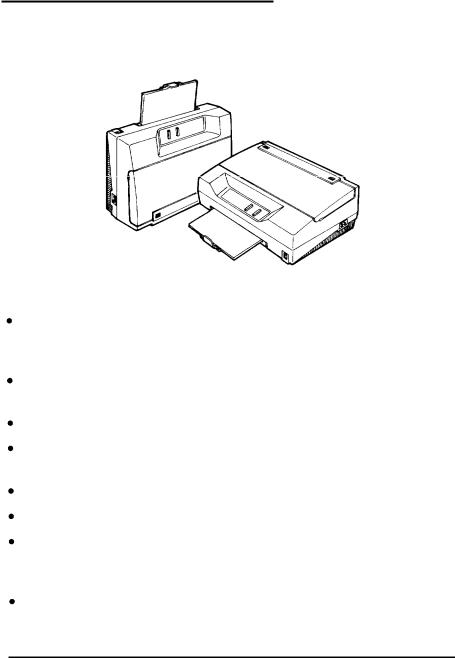
Choosing a Place for the Printer
The printer works flat or upright, as shown below. You can set it whichever way fits your preference or working space.
When selecting a place for your printer, follow these guidelines:
Place the printer on a flat, stable surface. Do not slide the printer on rough surfaces; you may damage the flap on the bottom otherwise.
Place the printer close enough to the computer for its interface cable to reach the computer.
Leave adequate room for easy operation and maintenance.
Avoid locations that are subject to direct sunlight, excessive heat, moisture, or dust.
Use a grounded outlet; do not use an adapter plug.
Place the printer where you can easily unplug the power cord.
Avoid electrical outlets controlled by wall switches or automatic timers. And avoid outlets on the same circuit as large motors or other appliances that can cause fluctuations in line voltage.
Keep the entire computer system away from potential sources of electromagnetic interference, such as loudspeakers or the base units of cordless telephones.
1-4 Setting Up the Printer
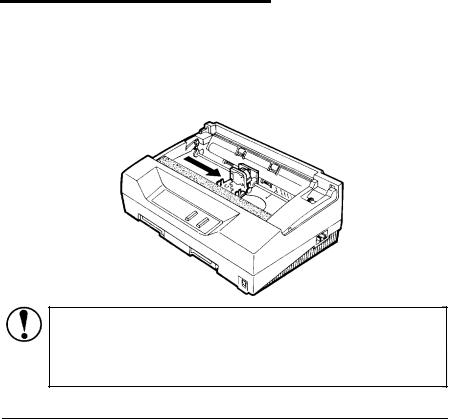
Choosing a Place for the Printer
If you plan to use a printer stand, follow these guidelines:
•Use a stand that supports at least 9 kg (20 lbs).
•Never use a stand that tilts the printer. It should always be kept level.
•Make sure to provide enough clearance below the stand and between the legs so your continuous paper feeds smoothly.
•Place cables so they do not interfere with paper feeding; secure them to a leg of the stand if possible.
•Align the continuous paper stack so the paper feeds straight into the optional tractor’s sprocket units.
Installing the Ribbon Cartridge
Before you install the ribbon cartridge, make sure the power cord is not plugged into an electrical outlet.
1.Use the tabs on both sides of the printer cover to lift it off the printer. Then slide the print head to the middle of the printer.
CAUTION: Never move the print head while the printer is turned on; this can damage the printer. Also, if you have just used the printer, let the print head cool for a few minutes before you touch it.
Setting Up the Printer |
1-5 |
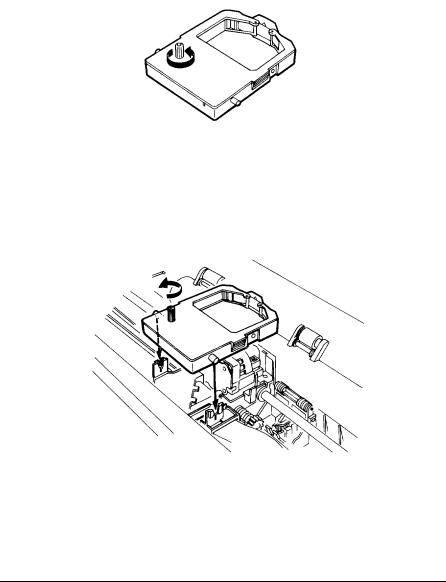
Installing the Ribbon Cartridge
2.Turn the ribbon-tightening knob in the direction of the arrow to remove any slack in the ribbon.
3.Insert the ribbon cartridge into the printer as shown; then press both sides of the cartridge firmly to fit the plastic posts into the slots.
4.Turn the ribbon-tightening knob to feed the ribbon into place. Make sure it is not twisted or creased.
1-6 Setting Up the Printer
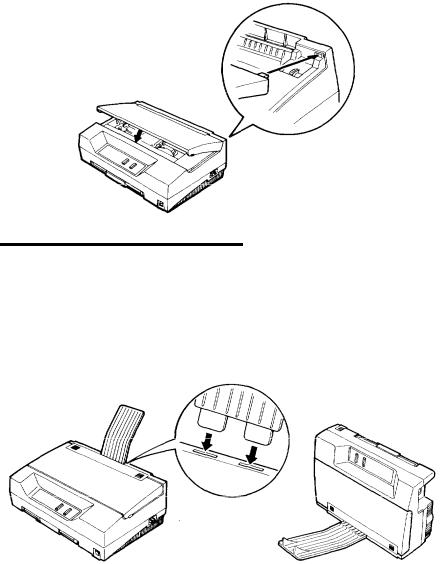
Installing the Ribbon Cartridge
5.Replace the printer cover by inserting its tabs into the holes on the printer as shown below; then close the cover.
Attaching the Output Guide
You can install the output guide to support printed pages as they come out of the printer. To install it, insert the tabs on the guide into the mounting slots on the printer case as shown below. Be sure to turn the guide over and install it in the opposite direction when you use the printer in the upright position.
Setting Up the Printer |
1-7 |
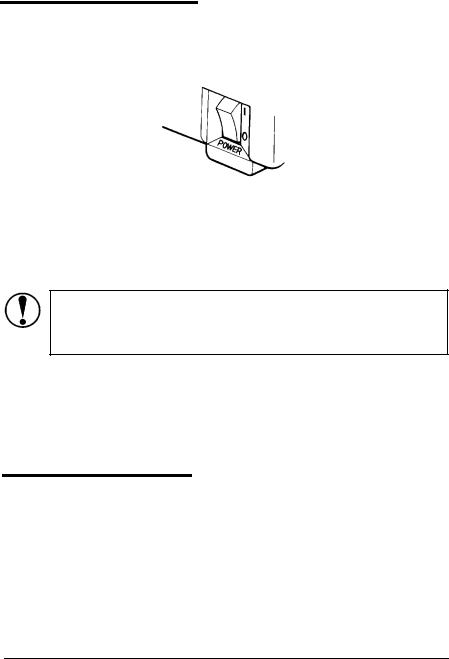
Plugging in the Printer
1.Make sure the power switch on the printer is turned off. It is off when the  side of the switch is pressed down.
side of the switch is pressed down.
2.Check the label on the back of the printer to make sure the voltage required by the printer matches that of your electrical outlet.
CAUTION: If the rated voltage and your outlet voltage do not match, contact your dealer for assistance. Do not plug in the power cord.
3.If the power cord is not attached to the printer, connect it to the AC inlet on the printer.
4.Plug the power cord into a properly grounded electrical outlet.
Running the Self Test
You can run the self test with either continuous paper or single sheets; this section describes the easier way, with single sheets.
1-8 Setting Up the Printer
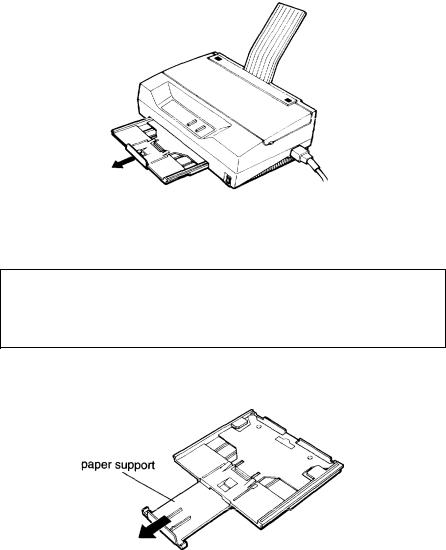
Running the Self Test
Loading paper into the paper cassette
1.Pull the paper cassette out of the printer.
2.Fan a stack of A4or letter-size paper and then tap it on a flat surface to even the edges.
Note: The US version uses letter-size paper; all others use A4 paper. The paper size (letter or A4) is shown the inside of the paper cassette. The cassette holds up to 50 sheets (70 kg or 22 lb maximum).
3. Pull out the paper support.
Setting Up the Printer |
1-9 |
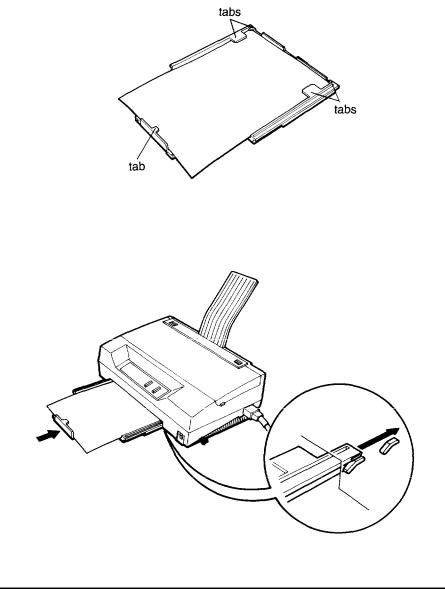
Running the Self Test
4.While holding down the metal plate in the paper cassette, put the paper in the cassette. Make sure the paper is underneath all five tabs, especially the small ones on the top edge of the cassette.
5.Insert the paper cassette into the printer as far as it will go. The edge of the paper stack extends beyond the front of the printer.
l-10 Setting Up the Printer

Running the Self Test
Running the test
1.Make sure the printer is turned off.
2.While holding down the FORM FEED (m) button, turn on the printer. It loads the paper automatically and begins the self test.
The printer prints characters in the current font and character table. Here is part of a typical self test:
!"#$%&I()*+,-./0123456789:;<=>?@ABCDEFGHIJKL !'I#$%&'( )*+,-. /0123456789:;<=>?@ABCDEFGHIJKLM "#$%&I()*+,-./0123456789:;<=>?@ABCDEFGHIJKLMN
#$%&I()*+,-./0123456789:;<=>?@ABCDEFGHIJKLMNCJ $%&I ()*+,-. /0123456789:;<=>?@ABCDEl?GHIJKLMNOP %a'()*+,-. /0123456789:; <=>?@ABCDEFGHIJKLMNOPQ %I()*+,-. 10123456789:; <=>?@ABCDEFGHIJKLMNOPQR
Note: If the paper cassette is empty when you turn the power on, the printer beeps three times and the light flashes. Load paper as described above and press the FORM FEED button to start the self test.
3. To stop the self test, turn off the printer.
Connecting the Printer to Your Computer
If the self test prints correctly, you’re ready to connect your printer to the computer. You need a shielded twisted-pair parallel cable to connect your computer to the printer’s built-in parallel interface.
Follow these steps to connect the parallel interface cable:
1.Make sure both the printer and computer are turned off; then plug the cable connector securely into the printer’s interface connector.
Setting Up the Printer |
l-11 |

Connecting the Printer to Your Computer
2.Squeeze the wire clips together until they lock in place on either side.
Note: If your cable has a ground wire, connect it to the ground connector below the interface connector.
3.Put the cable through the cable clip; then insert the clip in the slot on the bottom of the printer.
l-12 Setting Up the Printer
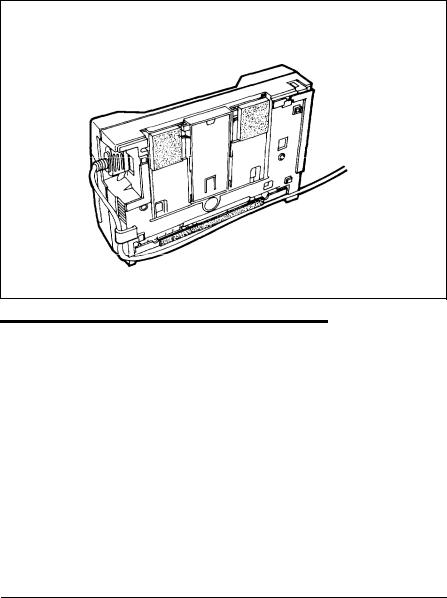
Connecting the Printer to Your Computer
4.Plug the other end of the cable into the computer. If there is a ground wire at the computer end of the cable, attach it to the ground connector at the back of the computer.
Note: If you want the power cord or interface cable to be on the opposite side, route it through the slot on the back.
Setting Up Your Application Software
Most application programs let you specify the type of printer you use so that the program can take full advantage of the printer’s features. Many programs provide an installation or setup menu that presents a list of printers.
Setting Up the Printer |
1-13 |
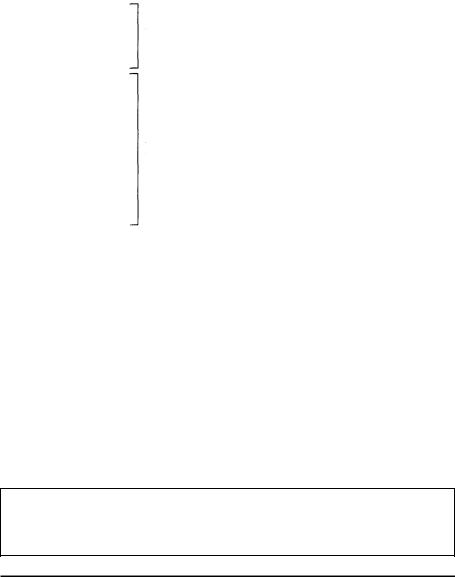
Setting Up Your Application Software
TO take full advantage at your printer’s features, including ESC/P 2, choose one of the first four printers on the list below. If none of these is listed, contact your software manufacturer for an update that includes one of the four. Until you receive an update, choose another printer as close to the top of the list as possible.
LQ-100
ActionPrinter 3250 ESC/P2
LQ-570
LQ-870
LQ-510/550
LQ-860
LQ-850
LQ-200
LQ-500 ESC/P
LQ-2550
LQ-2500
LQ-800
LQ-1500
If none of these printers is listed among your program’s options, select the first available of the following: EX, FX, LX, RX, MX, Epson printer, Standard printer, Draft printer. Because these are 9-pin printers, however, your graphics printing may not be correct.
Printing a test file
After you select the most appropriate printer as described above, create and print a test file using the fonts, symbols, features, and formats that you use most often. Printing the test file shows you how the printer works with your application program.
If the printing results are not what you expect, see Troubleshooting in Chapter 3, or consult your computer or software manual.
Note: When you print full resolution graphics (360 x 360 dpi), the result may have a slightly smudged appearance. If this occurs, choose a lower resolution in your application software.
1 - 1 4 Setting Up the Printer
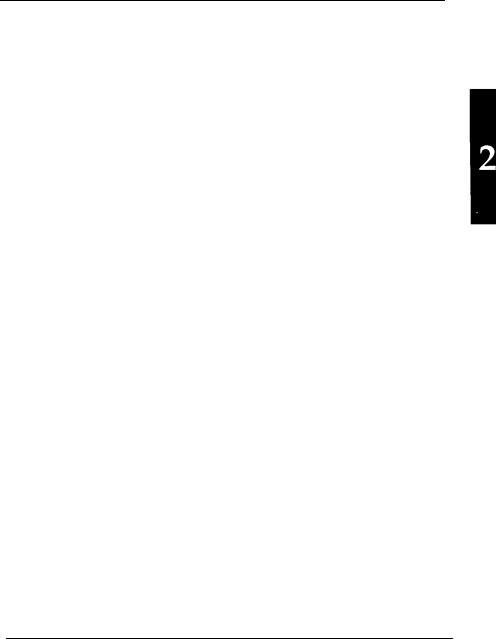
Chapter 2
Paper Handling
Printing on Single Sheets ......................................................... |
2-2 |
Tips for using the paper cassette ....................................... |
2-2 |
Loading paper manually.. ................................................... |
2-3 |
Using Continuous Paper with the Optional Push Tractor.. 2-5 Installing the push tractor ................................................... 2-5
Loading continuous paper .................................................. |
2-7 |
Tips for using continuous paper ........................................ |
2-10 |
Using the tear-off feature .................................................... |
2-11 |
Removing the push tractor ................................................. |
2-11 |
Switching Between Continuous Paper and Single Sheets . . . 2-13 Switching to single sheets . . . . . . . . . . . . . . . . . . . . . . . . . . . . . . . . . . . . . . . . . . . . . . . . . . . 2-13 Switching to continuous paper . . . . . . . . . . . . . . . . . . . . . . . . . . . . . . . . . . . . . . . . . . 2-14
Printing on Special Paper ......................................................... |
2-15 |
Adjusting the paper-thickness lever ................................. |
2-15 |
Envelopes .............................................................................. |
2-16 |
Multi-part forms ................................................................... |
2-17 |
Labels ..................................................................................... |
2-17 |
Paper Handling 2-l
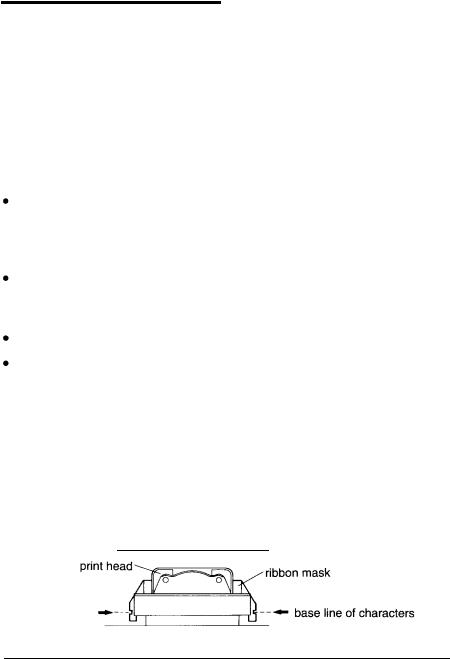
Printing on Single Sheets
You can load standard-sized single sheets with the paper cassette and you can load single sheets of paper from 148 mm (5.8 inches) to 257 mm (10.1 inches) wide with the manual insertion slot.
Tips for using the paper cassette
To review the steps for loading paper in the paper cassette, see “Loading paper into the paper cassette” on page 1-9. The tips below help you get the best performance when printing with the cassette.
Load paper in the paper cassette before you turn on the printer and send data. When the printer receives data from the computer, it loads a single sheet automatically and begins to print.
If the printer runs out of paper during a print job, reload the paper cassette and press the FORM FEED button to load the paper.
Press the FORM FEED button to eject a sheet of loaded paper.
You can adjust the top-of-form position with the gear under the printer cover. It is marked by + and - signs. Open the printer cover and turn the gear to adjust the position. The notches on the ribbon mask indicate the base line of printed characters. The gear adjustment affects only the loaded page. If you want to change the top-of-form position permanently, you can adjust it in the default-setting mode described in Chapter 3. However, most application software programs take care of the top and bottom margins. You usually don’t need to set the top-of-form position on the printer.
2-2 Paper Handling

Printing on Single Sheets
•When you want to push the paper support back into the paper cassette, first remove paper from the paper cassette. Then push the paper support in while pushing down on the locking tab.
•The default page length for the paper cassette is 65 lines (A4-size paper) or 61 lines (letter-size paper). You can change it using your application software or printer commands, if necessary. See the Appendix for more about printer commands.
•You can switch to manual insertion or to the optional push tractor without removing the paper cassette. For instructions, see “Loading paper manually” or “Switching Between Continuous Paper and Single Sheets” later in this chapter.
Loading paper manually
You can load single sheets of paper from the rear manual insertion slot. (If you’ve installed the optional push tractor, remove it before loading paper manually.)
1.Place the printer in the upright position and turn it on.
Paper Handling 2-3
